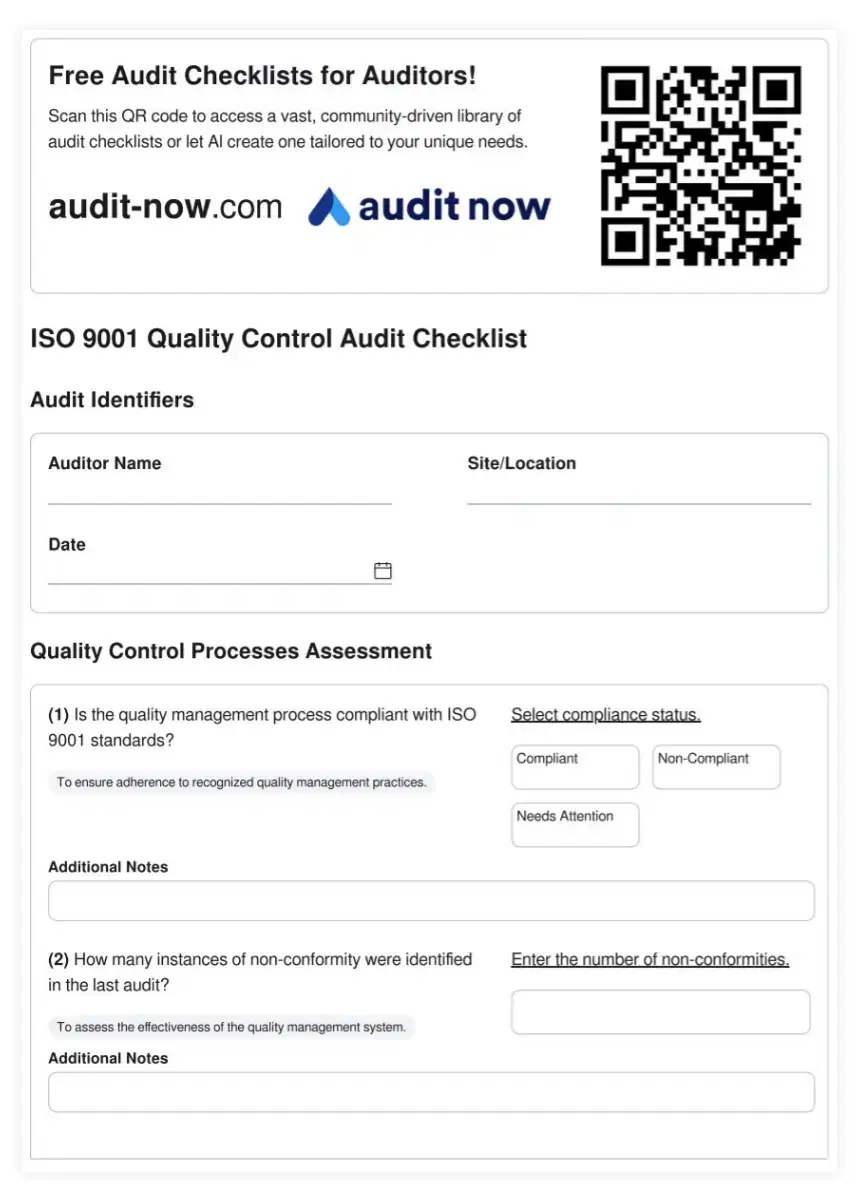Cybersecurity Audit 101: A Guide to Increase Compliance
A cybersecurity audit reviews systems and policies to find risks and ensure compliance. Challenges include limited resources, evolving threats, and complex reporting. Tools like Audit Now simplify audits with digital checklists and clear reporting, making the process more efficient and effective.
17 Apr 2025
•
Beril Işık

Featured Checklist

NIST Cybersecurity Framework Implementation Checklist
The NIST Cybersecurity Framework Implementation Checklist is a crucial tool for organizations in the Information Technology sector seeking to enhance their cybersecurity posture. This comprehensive checklist aligns with the National Institute of Standards and Technology (NIST) Cybersecurity Framework, providing a structured approach to identifying, protecting, detecting, responding to, and recovering from cyber threats. By utilizing this checklist, organizations can systematically assess their current security measures, identify gaps, and implement robust cybersecurity practices that adhere to industry-leading standards.
A cyber security audit is a systematic evaluation of an organization’s information systems, policies, and controls to ensure they effectively protect data and comply with relevant standards. It involves reviewing technical infrastructure, security policies, and staff practices to identify vulnerabilities, assess risks, and recommend improvements. In this guide, I will outline what a cybersecurity audit entails, common challenges organizations face, and how digital tools like Audit Now can help simplify and improve the audit process.
What Is a Cybersecurity Audit?
A cyber security audit examines how well an organization’s technologies, policies, and people work together to reduce risks from cyber threats. The audit process is often based on widely accepted frameworks and standards such as:
- NIST Cybersecurity Framework (CSF): Emphasizes five core functions—Identify, Protect, Detect, Respond, and Recover.
- ISO/IEC 27001: An international standard for information security management systems (ISMS), requiring organizations to implement and maintain a set of security controls.
- CIS Controls: A prioritized list of actions to mitigate the most common cyber threats.
Many organizations undergo audits to meet regulatory requirements or industry standards, especially those handling sensitive data or working with government agencies. The audit scope typically covers areas such as asset management, access controls, network security, data protection, incident response, and compliance documentation.
Common Pain Points in Cybersecurity Audits
Defining the Audit Scope
One of the first challenges is determining what to include in the audit. A scope that is too broad can overwhelm resources and extend timelines, while a scope that is too narrow risks missing critical vulnerabilities. Aligning the audit scope with business objectives, risk priorities, and compliance needs requires coordination across IT, security, compliance, and business units.
Keeping Up with the Evolving Threat Landscape
Cyber threats and technology evolve rapidly. Audit methodologies must be updated regularly to address new vulnerabilities and regulatory changes. Organizations that fail to adapt risk overlooking emerging threats.
Resource Constraints
Many organizations face limited budgets, staff shortages, or lack of specialized expertise, which can restrict audit depth and frequency. Skilled cybersecurity professionals are in high demand, making it difficult to allocate sufficient resources for thorough audits and timely remediation.
Manual and Time-Consuming Processes
Traditional audits often rely on manual evidence collection, documentation, and remediation tracking. These processes are labor-intensive and prone to errors, which can compromise the accuracy and reliability of audit results.
Complex Reporting Requirements
Communicating technical audit findings clearly to both technical teams and non-technical stakeholders such as executives or board members is challenging. Reports must balance detail with clarity and prioritize actionable recommendations.
Managing Overlapping Compliance Requirements
Organizations often need to comply with multiple standards—such as NIST, ISO 27001, PCI DSS, HIPAA, and GDPR—each with unique but sometimes overlapping requirements. This can lead to duplicated effort and confusion.
In this case, Audit Now can help while addressing key cybersecurity audit challenges like unclear scope, evolving threats, and limited resources. With digital checklists and customizable templates, it makes it easier to plan audits, assign tasks, and track progress in one place. Teams can reduce manual effort, stay organized, and respond quickly to changes. It also simplifies reporting for both technical and non-technical audiences, making the entire audit process more efficient and manageable.
Discover Checklists
Access ready-made cybersecurity checklists—get started with just one click.
Access
Preparing for a Cybersecurity Audit
I believe that successful audits require preparation. Best practices include:
- Forming a cross-functional audit team with cybersecurity, IT, and compliance expertise.
- Identifying all applicable regulations and standards.
- Consolidating controls from multiple frameworks into a unified checklist.
- Scheduling audits and reviews in advance.
- Gathering documentation and evidence to demonstrate compliance.
To wrap up, cybersecurity audits are vital for identifying risks, ensuring compliance, and strengthening security posture. Understanding common challenges and leveraging structured digital platforms like Audit Now can transform audits from a burdensome task into a strategic advantage—helping organizations protect their assets and maintain trust in an increasingly complex cyber environment.
Looking for a simpler way to manage cybersecurity audits? Tools like Audit Now can help digitize and streamline your process.
Audit 101: Learn More